 | |
| Place of origin | Macau [1] |
|---|---|
Arroz gordo (literally Fat rice) is a rice dish that is often consumed by Eurasian communities in Goa, Macao, Malaysia, and Singapore. [2] It has been likened to a variant of Paella. [3]
 | |
| Place of origin | Macau [1] |
|---|---|
Arroz gordo (literally Fat rice) is a rice dish that is often consumed by Eurasian communities in Goa, Macao, Malaysia, and Singapore. [2] It has been likened to a variant of Paella. [3]
The gordo in Arroz gordo denotes the richness and expanse of the ingredients. [4]
Arroz gordo is often eaten during festive and/or special occasions, [2] such as Christmas. [5]
While different recipes call for different ingredients, Arroz gordo contains rice, chorizo (or sausage), Chicken, Pork and hard-boiled eggs. [2] [3] [5]
The dish can take two days or more to make. [3]
The Chicago restaurant Fat Rice takes its name from the dish.

Paella is a rice dish originally from the Valencian Community. Paella is regarded as one of the community's identifying symbols. It is one of the best-known dishes in Spanish cuisine.

Fried rice is a dish of cooked rice that has been stir-fried in a wok or a frying pan and is usually mixed with other ingredients such as eggs, vegetables, seafood, or meat. It is often eaten by itself or as an accompaniment to another dish. Fried rice is a popular component of East Asian, Southeast Asian and certain South Asian cuisines, as well as a staple national dish of Indonesia. As a homemade dish, fried rice is typically made with ingredients left over from other dishes, leading to countless variations. Fried rice first developed during the Sui dynasty in China.

Pilaf, pilav or pilau is a rice dish, usually sautéed, or in some regions, a wheat dish, whose recipe usually involves cooking in stock or broth, adding spices, and other ingredients such as vegetables or meat, and employing some technique for achieving cooked grains that do not adhere to each other.
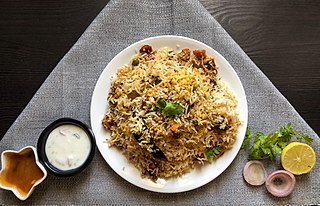
Biryani is a mixed rice dish, mainly popular in South Asia. It is made with rice, some type of meat and spices. To cater to vegetarians, in some cases, it is prepared by substituting vegetables or paneer for the meat. Sometimes eggs and/or potatoes are also added.

Mexican rice, also known as arroz a la mexicana, arroz mexicano, sopa de arroz, or arroz rojo in Spanish, is a Mexican side dish made from white rice, tomato, garlic, onion, and perhaps other ingredients. Mexican rice is almost always eaten as a complement to other dishes such as mole, refried beans, rotisserie chicken, carne asada, picadillo, tacos, fried fish, fried chicken, chiles rellenos, or vegetable soup.

Filipino cuisine is composed of the cuisines of more than a hundred distinct ethnolinguistic groups found throughout the Philippine archipelago. A majority of mainstream Filipino dishes that compose Filipino cuisine are from the food traditions of various ethnolinguistic groups and tribes of the archipelago, including the Ilocano, Pangasinan, Kapampangan, Tagalog, Bicolano, Visayan, Chavacano, and Maranao ethnolinguistic groups. The dishes associated with these groups evolved over the centuries from a largely indigenous base shared with maritime Southeast Asia with varied influences from Chinese, Spanish, and American cuisines, in line with the major waves of influence that had enriched the cultures of the archipelago, and adapted using indigenous ingredients to meet local preferences.

Soto ayam is a traditional Indonesian dish with ingredients such as chicken, lontong, noodles, and rice vermicelli. Soto ayam is popular in Singapore, Malaysia and Suriname. Turmeric is added as one of its main ingredients which makes the yellow chicken broth. It is one of the most popular variants of soto, a traditional soup commonly found in Indonesian cuisine. Besides chicken and vermicelli can also be served with hard-boiled eggs, slices of fried potatoes, and Chinese celery leaves. Fried shallots are usually added as a garnish. Coconut milk (santan) is also used as an additional ingredient. Koya, a powder of mixed prawn crackers with fried garlic, or sambal is a common topping. Krupuk or emping is also a common topping. Lalapan is usually served as a side dish.

Rice and beans, or beans and rice, is a category of dishes from many cultures around the world, whereby the staple foods of rice and beans are combined in some manner. The grain and legume combination provides several important nutrients and many calories, and both foods are widely available. The beans are usually seasoned, while the rice may be plain or seasoned. The two components may be mixed together, separated on the plate, or served separately.

Fried noodles are common throughout East Asia, Southeast Asia and South Asia. Many varieties, cooking styles, and ingredients exist.

Colombian cuisine is a culinary tradition of the six main regions within Colombia. Colombian cuisine varies regionally and is influenced by Indigenous Colombian, Spanish, and African cuisines, with a slight Arab influence in some regions.
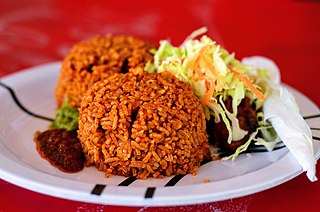
Jollof, or jollofrice, is a rice dish from West Africa. The dish is typically made with long-grain rice, tomatoes, chilies, onions, spices, and sometimes other vegetables and/or meat in a single pot, although its ingredients and preparation methods vary across different regions. The dish's origins are traced to Senegal.

Picadillo is a traditional dish in many Latin American countries including Mexico and Cuba, as well as the Philippines. It is made with ground meat, tomatoes, and also raisins, olives, and other ingredients that vary by region. The name comes from the Spanish word picar, meaning "to mince".
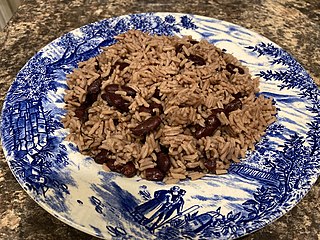
Rice and peas or peas and rice are traditional rice dishes within some Caribbean countries. The 'peas' used in this dish by some countries are traditionally pigeon peas otherwise called 'Gungo peas' in the Caribbean. Either kidney beans or pigeon peas are generally used for this dish. Rice and peas recipes throughout the Caribbean vary, with each country having their own way of making it and name of calling it, and are similar only by the two main ingredients which are the legumes (peas/beans) used and rice to form a mixture. The name "rice and peas" originally is used by Jamaicans to identify the dish, while other countries have different names for it.
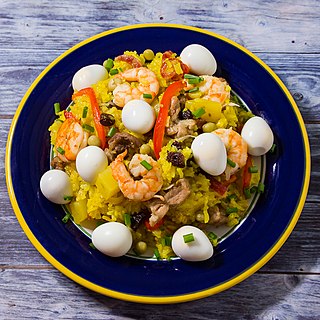
Arroz a la valenciana or Valencian rice is a name for a multitude of rice dishes from diverse cuisines of the world, which originate from the rice-cooking tradition of the Valencian Community, in eastern Spain.

Chinese fried rice is a family of fried rice dishes popular in Greater China and around the world. It is sometimes served as the penultimate dish in Chinese banquets, just before dessert.

Arroz caldo is a Spanish term meaning "broth rice". It is derived from the Spanish dish arroz caldoso.

Arroz chaufa, also known as chaufa, is a fried rice dish from Peru. It is part of the Chinese Peruvian cuisine, which is called chifa.
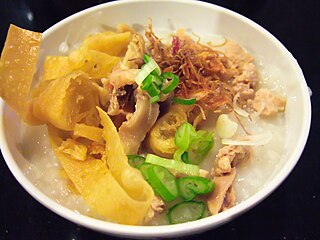
Bubur ayam is an Indonesian chicken congee. It is rice congee with shredded chicken meat served with some condiments, such as chopped scallion, crispy fried shallot, celery, tongcay or chai poh, fried soybean, crullers, both salty and sweet soy sauce, and sometimes topped with yellow chicken broth and kerupuk. Unlike many other Indonesian dishes, the dish is not spicy as the sambal or chili paste is often served separately. It is a favourite breakfast food, served by humble travelling vendors, warung, fast food establishments, and five-star hotel restaurants. Travelling bubur ayam vendors frequently pass through residential streets in the morning selling the dish.
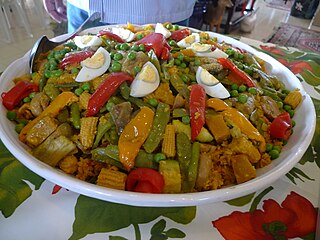
Paelya or paella (Spanish) is a Philippine rice dish adapted from the Valencian paella. However, it differs significantly in its use of native glutinous rice (malagkít), giving it a soft and sticky texture, unlike the al dente texture favoured in Spanish paella. It is also characteristically topped with sliced eggs. Filipino paelya does not use saffron, but is instead coloured with atsuete (anatto), luyang diláw (turmeric), or kasubhâ (safflower).
Abraham Conlon is an American chef and a native of Lowell, Massachusetts, of Portuguese heritage. Conlon is the winner of the 2018 James Beard Foundation Award for Best Chef: Great Lakes.